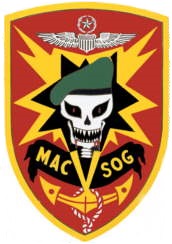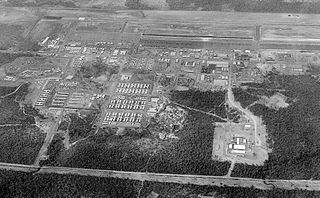
The Laotian Civil War was waged between the Communist Pathet Lao and the Royal Lao Government from 23 May 1959 to 2 December 1975. The Kingdom of Laos was a covert theater during the Vietnam War with both sides receiving heavy external support in a proxy war between the global Cold War superpowers. The fighting also involved the North Vietnamese, South Vietnamese, American and Thai armies, both directly and through irregular proxies. The war is known as the Secret War among the American CIA Special Activities Center, and Hmong and Mien veterans of the conflict.

Military Assistance Command, Vietnam – Studies and Observations Group (MACV-SOG) was a highly classified, multi-service United States special operations unit which conducted covert unconventional warfare operations before and during the Vietnam War.
The United States Air Force (USAF) deployed combat aircraft to Thailand from 1960 to 1975 during the Vietnam War. Today, US military units train with other Asian militaries in Thailand. Royal Thai Air Force Bases are an important element in the Pentagon's "forward positioning" strategy.

The Nakhon Phanom Royal Thai Navy Base (NKP), formerly Nakhon Phanom Royal Thai Air Force Base, is a Royal Thai Navy facility used for riverine patrols along the Mekong River. It is approximately 587 km (365 mi) northeast of Bangkok, 14.5 km (9.0 mi) west of Nakhon Phanom city in Nakhon Phanom Province in the northeastern region of Thailand, and 411 km (255 mi) from Hanoi in Vietnam. The Mekong River is NKP's border with Laos. The airfield at NKP is jointly used as a civilian airport.
Udorn Royal Thai Air Force Base is a Royal Thai Air Force (RTAF) base, the home of 23rd Wing Air Command. It is in the city of Udon Thani in northeastern Thailand and is the main airport serving the city and province.
The Programs Evaluation Office was a covert paramilitary mission to the Kingdom of Laos, established on 13 December 1955 by the United States Department of Defense. The 23 July 1962 International Agreement on the Neutrality of Laos would cause it to be shut down in September 1962. It would be succeeded by the Requirements Office.

The Battle of Lima Site 85, also called Battle of Phou Pha Thi, was fought as part of a military campaign waged during the Vietnam War and Laotian Civil War by the North Vietnamese People's Army of Vietnam (PAVN) and the Pathet Lao, against airmen of the United States Air Force (USAF)'s 1st Combat Evaluation Group, elements of the Royal Lao Army, Royal Thai Border Patrol Police, and the CIA-led Hmong Clandestine Army. The battle was fought on Phou Pha Thi mountain in Houaphanh Province, Laos, on 10 March 1968, and derives its name from the mountaintop where it was fought or from the designation of a 700-foot (210 m) landing strip in the valley below, and was the largest single ground combat loss of United States Air Force members during the Vietnam War.

Operation Barrel Roll was a covert U.S. Air Force 2nd Air Division and U.S. Navy Task Force 77, interdiction and close air support campaign conducted in the Kingdom of Laos between 14 December 1964 and 29 March 1973 concurrent with the Vietnam War. The operation resulted in 260 million bombs being dropped on Laos.

Operation Pony Express was the covert transportation of, and the provision of aerial support for, indigenous soldiers and material operating across the Laotian and North Vietnamese borders during the Vietnam War. It was provided by Sikorsky CH-3C helicopters of the US 20th Helicopter Squadron, the only USAF combat helicopter squadron in Vietnam, which had been transferred there in 1965 and was known as the "Pony Express".

CIA activities in Laos started in the 1950s. In 1959, U.S. Special Operations Forces began to train some Laotian soldiers in unconventional warfare techniques as early as the fall of 1959 under the code name "Erawan". Under this code name, General Vang Pao, who served the royal Lao family, recruited and trained his Hmong and Iu-Mien soldiers. The Hmong and Iu-Mien were targeted as allies after President John F. Kennedy, who refused to send more American soldiers to battle in Southeast Asia, took office. Instead, he called the CIA to use its tribal forces in Laos and "make every possible effort to launch guerrilla operations in North Vietnam with its Asian recruits." General Vang Pao then recruited and trained his Hmong soldiers to ally with the CIA and fight against North Vietnam. The CIA itself claims that the CIA air operations in Laos from 1955 to 1974 were the "largest paramilitary operations ever undertaken by the CIA."

The Raven Forward Air Controllers, also known as The Ravens, were fighter pilots used as forward air controllers (FACs) in a covert operation in conjunction with the US Central Intelligence Agency in Laos during America's Vietnam War. The Ravens pinpointed targets for most of the air strikes against communist Pathet Lao and People's Army of Vietnam infiltrators in support of the Laotian Hmong guerrilla army.

The RTAF Security Force Command is a Division size unit in the Royal Thai Air Force. It has been in existence since 1937. They are based near Don Mueang International Airport. The RTAF Security Force Command is the main air force ground forces and special forces which providing light infantry for anti-hijacking capabilities, protecting air bases and high value assets, protecting international airport in insurgent areas. It also serves as the Royal Thai Air Force Special Operations Regiment which consists of various units such as Combat Control Team (CCT), Pararescue Jumpers (PJs), Tactical Air Control Party (TACP). Ground forces in this unit use textbooks similar to those used by Royal Thai Army infantrymen, whether it is in terms of first aid, forward observer, hand and arm signals, hand-to-hand combat, jungle warfare, light and heavy weapons, living off the jungle, radio communications, raiding and reconnaissance tactics, use a map and compass, and other knowledge related to infantry. But with the fact that they are an air force ground force, they have received additional training with an emphasis on protection air base and airport in response to the mission of the agency. Therefore, they received additional training about CBRN defense, combat and patrolling in urban areas, counter-sabotage air base and airport, CQB and CQC, crowd control when chaos near air base and airport, inspection and interception techniques before entering the air base and airport, defense reconnaissance in air base and airport areas, respond to anti-hijacking capabilities, using advanced technology to against aircraft threats and support air operations, and other skills related to self-defense on the battlefield if the fire base is attacked or attacked while moving.

The Royal Lao Armed Forces, best known by its French acronym FAR, were the official armed defense forces of the Kingdom of Laos, a state that existed from 1949 to 1975 in what is now the Lao People's Democratic Republic. First created under the French protectorate of Laos on July 1, 1949, the FAR was responsible for the defense of the Kingdom since its independence in October 1953 from France, until its dissolution on December 2, 1975. It operated notably during the North Vietnamese invasion of Laos and the Laotian Civil War from 1960 to 1975.

James William Lair was an influential Central Intelligence Agency paramilitary officer from the Special Activities Division. He was a native Texan, raised in a broken family, but a good student. He joined the CIA after serving in a combat unit in Europe during World War II, followed by a geology degree from Texas A&M. In his senior year, he was recruited by the CIA.
William Young was a Central Intelligence Agency paramilitary officer born in Berkeley, California and raised in Burma and Thailand. Although he was Caucasian, he was reared in the local hill tribe culture. Because his father and brother already worked for the CIA and knew Bill Lair, the Agency knew of his extensive cultural contacts with the Lahu people and other Southeast Asian hill tribes. With command of several Asian languages, he was made a natural recruiter of local guerrillas for the CIA's covert operations in the secret war in the Kingdom of Laos. He was then considered for the position of case officer to the Hmong Vang Pao. He was passed over in favor of sending him on an extended reconnaissance of the Kingdom of Laos. His tour ranged westward from his start at Long Tieng, which he reported as well sited for operations in the Plain of Jars, back to familiar territory in the Golden Triangle.
Operation Momentum was a guerrilla training program during the Laotian Civil War. This Central Intelligence Agency operation raising a guerrilla force of Hmong hill-tribesmen in northeastern Laos was planned by James William Lair and carried out by the Thai Police Aerial Reinforcement Unit. Begun on 17 January 1961, the three-day Auto Defense Choc course graduated a clandestine guerrilla army of 5,000 warriors by 1 May, and of 9,000 by August. It scored its first success the day after the first ADC company graduated, on 21 January 1961, when 20 ADC troopers ambushed and killed 15 Pathet Lao.
Operation Triangle was a military operation of the Laotian Civil War staged from 19—29 July 1964. Although planned by the General Staff of the Royal Lao Army, it was subject to American approval because the RLA depended on the Americans for finances, supplies, and munitions. Operation Triangle was an ambitious undertaking dependent on martial skills unfamiliar to the Lao. It not only called for coordination of infantry, artillery, and tactical air strikes among forces of three different nationalities; as a covert operation, it also had to have plausible deniability.
Operation Millpond, which operated from 13 March 1961 through August 1961, was an American covert operation designed to introduce air power into the Laotian Civil War. A force of 16 B26s, 16 Sikorsky H-34s, and other military materiel was hastily shipped in from Okinawa and held ready to operate from the Kingdom of Thailand. After this hasty preparation for bombing in Laos, the debacle at the Bay of Pigs invasion resulted in the cancellation of Millpond. The B-26s were returned to Okinawa. However, the precedent had been set for covert Central Intelligence Agency-sponsored air operations in Laos.
The Battle of Vientiane was the decisive action of the 1960 Laotian coups. Fought between 13 and 16 December 1960, the battle ended with General Phoumi Nosavan winning control of the Kingdom of Laos with the aid of the Royal Thai Government and the U.S. Central Intelligence Agency. Vientiane was left devastated by the fighting, with about 600 civilians dead, about the same number of homes destroyed, and 7,000 left homeless. The losing Forces Armées Neutralistes under Captain Kong Le retreated onto the strategic Plain of Jars, to begin an uneasy coexistence with the Pathet Lao and the invading People's Army of Vietnam.
Project Waterpump was a secretive support operation by the U.S. Air Force to train and nurture into existence the Royal Lao Air Force (RLAF). The United States had decided to covertly support the Kingdom of Laos in the Laotian Civil War as the Lao fended off a North Vietnamese invasion. The nascent RLAF was seen as a force multiplier but needed pilots and technicians. The 40-man Detachment 6, 1st Air Commando Wing, code named Waterpump, was forwarded to Udorn Royal Thai Air Force Base for this training duty in March 1964. They would remain on duty through the truce of 21 February 1973. Their first hasty assignment was transition training to the T-28 Trojan for American civilian pilots; the resulting A Team would exist through 1967. The Air Commandos also conducted final training for Royal Thai Air Force (RTAF) mercenary pilots; the resultant B Team would serve until 1970. Besides putting a polish on graduate pilots, the Waterpump detachment trained Lao pilots from scratch. The RLAF's high pilot casualty rate made bringing the RLAF rosters up to strength a long grind.










